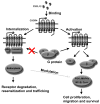Multiple roles of chemokine CXCL12 in the central nervous system: a migration from immunology to neurobiology
- PMID: 18177992
- PMCID: PMC2324067
- DOI: 10.1016/j.pneurobio.2007.11.003
Multiple roles of chemokine CXCL12 in the central nervous system: a migration from immunology to neurobiology
Abstract
Chemotactic cytokines (chemokines) have been traditionally defined as small (10-14kDa) secreted leukocyte chemoattractants. However, chemokines and their cognate receptors are constitutively expressed in the central nervous system (CNS) where immune activities are under stringent control. Why and how the CNS uses the chemokine system to carry out its complex physiological functions has intrigued neurobiologists. Here, we focus on chemokine CXCL12 and its receptor CXCR4 that have been widely characterized in peripheral tissues and delineate their main functions in the CNS. Extensive evidence supports CXCL12 as a key regulator for early development of the CNS. CXCR4 signaling is required for the migration of neuronal precursors, axon guidance/pathfinding and maintenance of neural progenitor cells (NPCs). In the mature CNS, CXCL12 modulates neurotransmission, neurotoxicity and neuroglial interactions. Thus, chemokines represent an inherent system that helps establish and maintain CNS homeostasis. In addition, growing evidence implicates altered expression of CXCL12 and CXCR4 in the pathogenesis of CNS disorders such as HIV-associated encephalopathy, brain tumor, stroke and multiple sclerosis (MS), making them the plausible targets for future pharmacological intervention.
Figures


References
-
- Al-Aoukaty A, Schall TJ, Maghazachi AA. Differential coupling of CC chemokine receptors to multiple heterotrimeric G proteins in human interleukin-2-activated natural killer cells. Blood. 1996;87:4255–60. - PubMed
-
- Altman J, Bayer SA. Embryonic development of the rat cerebellum. II. Translocation and regional distribution of the deep neurons. J Comp Neurol. 1985;231:27–41. - PubMed
-
- Alvarez S, Serramia MJ, Fresno M, Munoz-Fernandez M. Human immunodeficiency virus type 1 envelope glycoprotein 120 induces cyclooxygenase-2 expression in neuroblastoma cells through a nuclear factor-kappaB and activating protein-1 mediated mechanism. J Neurochem. 2005;94:850–61. - PubMed
-
- Ambrosini E, Remoli ME, Giacomini E, Rosicarelli B, Serafini B, Lande R, Aloisi F, Coccia EM. Astrocytes produce dendritic cell-attracting chemokines in vitro and in multiple sclerosis lesions. J Neuropathol Exp Neurol. 2005;64:706–15. - PubMed
Publication types
MeSH terms
Substances
Grants and funding
LinkOut - more resources
Full Text Sources
Other Literature Sources
Research Materials

